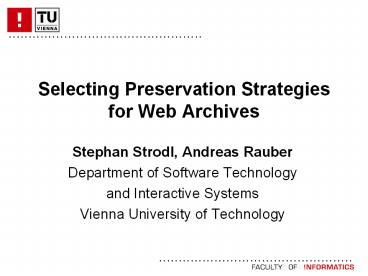Selecting Preservation Strategies for Web Archives - PowerPoint PPT Presentation
Title:
Selecting Preservation Strategies for Web Archives
Description:
Selecting Preservation Strategies for Web Archives. Stephan Strodl, ... quality of data (wrong mime type) crawler specific characteristics of data collection ... – PowerPoint PPT presentation
Number of Views:41
Avg rating:3.0/5.0
Title: Selecting Preservation Strategies for Web Archives
1
Selecting Preservation Strategies for Web
Archives
- Stephan Strodl, Andreas Rauber
- Department of Software Technology
- and Interactive Systems
- Vienna University of Technology
2
Motivation
- web archive systems store enormous amount of data
- no guarantee to reopen in 5, 10 or 20 years
- useless, waste of time money?
- digital preservation
- special challenges of web archives
- amount of data
- heterogeneity of file formats
- quality of data (wrong mime type)
- crawler specific characteristics of data
collection
3
Motivation
- different strategies for preservation of web
archives - original
- migration (ASCII, picture, video clip)
- standardization (minimal HTML)
- how do you know what is most suitable for your
needs? - what are your requirements?
- how do you measure and evaluate the results of
the preservation strategies?
4
Goals
- motivate and allow operators of web archives to
precisely specify their preservation
requirements(future usage of web archive) - provide structured model to describe and
document these - create defined setting to evaluate preservation
strategies - document outcome of evaluations to allow
informed, accountable decision
5
Utility Analysis
- cost-benefit analysis model
- used in the infrastructure sector
- adapted for digital preservation needs
- 14 steps grouped into 3 phases
- framework in cooperation of Vienna University of
Technology and National Archive Netherlands
6
Process Overview
7
Define basis
- types of records (e.g. Java applets, audio
streams, Flash, ..) - what are the essential characteristics?
- content, context(!), structure, form and
behaviour - specific task of web archives (e.g. e-gov vs.
historic websites) - requirements
- metadata
- authenticity, reliability, integrity, usability
8
Choose objects/records
- choose sample records
- a test-bed repository
- from own collection
- choice of records affects the evaluation
9
Identify objectives (1)
- list all requirements and goals in tree
structure - start from high-level goals
- break down to fine-granular, specific criteria
10
Identify objectives (2)
- usually 4 top-level branches
- object characteristics (content, metadata ...)
- record characteristics (context, relations, ...)
- process characteristics (scalability, error
detection, ...) - costs (set-up, per object, HW/SW, personnel, ...)
- define requirements for web archives
- preserve picture, video clip, text content,
interactivity - search, links, metadata
11
Identify objectives (3)
- objective tree with several hundred leaves
- usually created in workshops, brainstorming
sessions - re-using branches from similar institutions,
collection holdings, ...
12
Assign measurable units
- ensure that leaf criteria are objectively (and
automatically) measurable - seconds/Euro per object
- bits color depth
- ...
- subjective scales where necessary
- diffusion of file format
- amount of (expected) support
- ...
13
Set importance factors
- set importance factors
- not all leaf criteria are equally important
- set relative importance of all siblings in a
branch - weights are propagated down the tree to the leaves
14
Choose alternatives
- list and formally describe the preservation
action possibilities to be evaluated - tool, version
- operating system
- parameters
- alternatives for web archives
- original
- migration (ASCII, picture, video clip)
- standardization (minimal HTML)
15
Go/No-Go
- deliberate step for taking a decision whether it
will be useful and cost-effective to continue the
procedure, given - the resources to be spent (people, money)
- the expected result(s).
- review of the experiment/ evaluation process
design so far - e.g. is the design correct and optimal?
- is the design complete (given the objectives).
16
Specify resources
- detailed design and overview of the resources
- human resources (qualification, roles,
responsibility, ) - technical requirements (hardware and software
components) - time (time to run experiment,...)
- cost (costs of the experiments,...)
17
Develop experiment
- formulate for each experiment a detailed plan
- includes builds build and test software
components - mechanism to capture the result
- workflow/sequence of activities
18
Run experiment
- run experiment with the previously defined sample
records - the whole process need to be documented
- e.g. convert html file to pdf
19
Evaluate experiment
- evaluate how successfully the requirements are
met - measure performance with respect to leaf
criteria in the objective tree - document the results
20
Transform measured values
- measures come in seconds, euro, bits, goodness
values, - need to make them comparable
- transform measured values to uniform scale
- transformation tables for each leaf criterion
- linear transformation, logarithmic, special scale
- scale 1-5 plus "not-acceptable"
21
Aggregate values
- multiply the transformed measured values in the
leaf nodes with the leaf weights - sum up the transformed weighted values over all
branches of the tree - creates performance values for each alternative
on each of the sub-criteria identified
22
Consider results
- rank alternatives according to overall utility
value at root - performance of each alternative
- overall
- for each sub-criterion (branch)
- allows performance measurement of combinations of
strategies - final sensitivity analysis against minor
fluctuations in - measured values
- importance factors
23
Digital Pres. Utility Analysis Tool
24
Benefits
- a simple, methodologically sound model to
specify and document requirements - repeatable and documented evaluation for informed
and accountable decisions - set of templates to assist institutions
- generic workflow that can easily be integrated in
different institutional settings
25
Conclusion
- important to consider preservation for web
archives - web archive suitable for combination of
strategies - need a profound knowledge of future use of web
archives
26
- Questions ?































